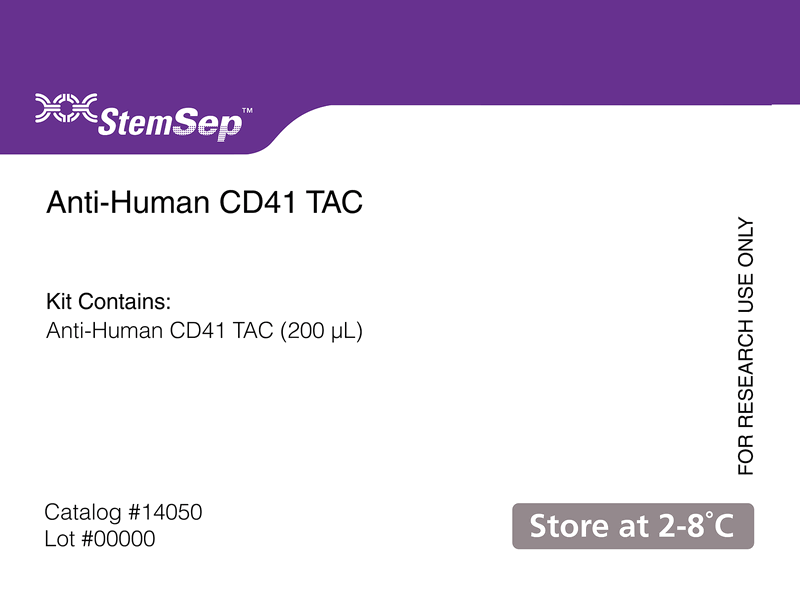StemSep™ Anti-Human CD41 TAC
Immunomagnetic depletion reagent
概要
The StemSep™ Anti-Human CD41 TAC is designed deplete CD41+ cells from human peripheral blood mononuclear cell samples. CD41+ cells are targeted for removal with bispecific Tetrameric Antibody Complexes (TAC), which are directed against CD41 and dextran. CD41 is expressed on platelets and megakaryocytes.
Components
- StemSep™ Anti-Human CD41 TAC (Catalog #14050)
- StemSep™ Anti-Human CD41 TAC, 0.2 mL
Magnet Compatibility
Subtype
Cell Isolation Kits
Cell Type
Megakaryocytes, Platelets
Species
Human
Sample Source
PBMC
Selection Method
Depletion
Application
Cell Isolation
Brand
StemSep
Area of Interest
Immunology, Stem Cell Biology
技术资料
| Document Type | 产品名称 | Catalog # | Lot # | 语言 |
|---|---|---|---|---|
| Product Information Sheet | StemSep™ Anti-Human CD41 TAC | 14050 | All | English |
| Manual | StemSep™ Anti-Human CD41 TAC | 14050 | All | English |
| Safety Data Sheet | StemSep™ Anti-Human CD41 TAC | 14050 | All | English |
数据及文献
Publications (2)
Journal of immunological methods 1989 JUN
Specific binding and release of cells from beads using cleavable tetrameric antibody complexes.
Abstract
Abstract
A two-step separation procedure is described for the positive selection of cells based on their reactivity with mouse monoclonal antibodies. In the first step cells are specifically cross-linked to hapten-modified glass beads using tetrameric monoclonal antibody complexes. In the second step bound cells are selectively eluted by reductive cleavage of the tetrameric antibody complexes. The latter are comprised of two mouse IgG1 monoclonal antibodies (one recognizing a cell surface antigen on target cells and the other a hapten coupled to the glass beads) bound together by two F(ab')2 fragments of rat anti-mouse IgG1 monoclonal antibody. The complexes provide a specific cleavable cross-link between cell and bead because the disulfide bonds between the two Fab' arms of the F(ab')2 fragments can be broken under relatively mild conditions using dithiothreitol. This specific cleavage of the cross-linker allows elution of the specifically absorbed cells without co-elution of non-specifically bound cells. This is shown in the purification of CD3+ T cells from human peripheral blood, where the removed fractions were over 90% pure and approximately 50% of the positive cells were recovered. Separation of cells labelled with limiting amounts of tetrameric antibody complexes demonstrated that this separation technique was also effective for the purification of cells expressing low amounts of antigens. This was confirmed by the purification of CD34-positive cells from human bone marrow. With this approach, colony-forming cells were enriched 15-24-fold over density separated marrow.
European journal of immunology 1986 JUN
Cyclic tetramolecular complexes of monoclonal antibodies: a new type of cross-linking reagent.
Abstract
Abstract
A simple and efficient procedure for the construction of bifunctional molecules is described and their use in a variety of applications documented. This procedure is based on our observation that mouse IgG1 monoclonal antibodies, when mixed with equimolar amounts of a high-affinity rat monoclonal antibody specific for mouse IgG1, yield uniform cyclic tetramolecular complexes each consisting of two mouse and two rat antibodies as shown by gel electrophoresis and electron microscopy. When solutions of two mouse antibodies (e.g. a and b) are mixed prior to the formation of complexes with the rat antibody, stable bispecific (a X b) complexes together with monospecific (a X a and b X b) complexes are obtained. Bispecific complexes prepared in this way were able to efficiently bind peroxidase to cell surface antigens, and to bind red blood cells to selected nucleated cell types present in heterogeneous populations. Tetrameric antibody complexes are more easily prepared than bispecific antibodies or bifunctional antibodies produced by transfection of myelomas with recombinant genes. They also have the advantage that the antigen-binding properties of the bivalent monoclonal antibodies are not compromised. Tetrameric antibody complexes thus represent a powerful new type of cross-linking reagent that may have a wide spectrum of applications in biology and medicine.


